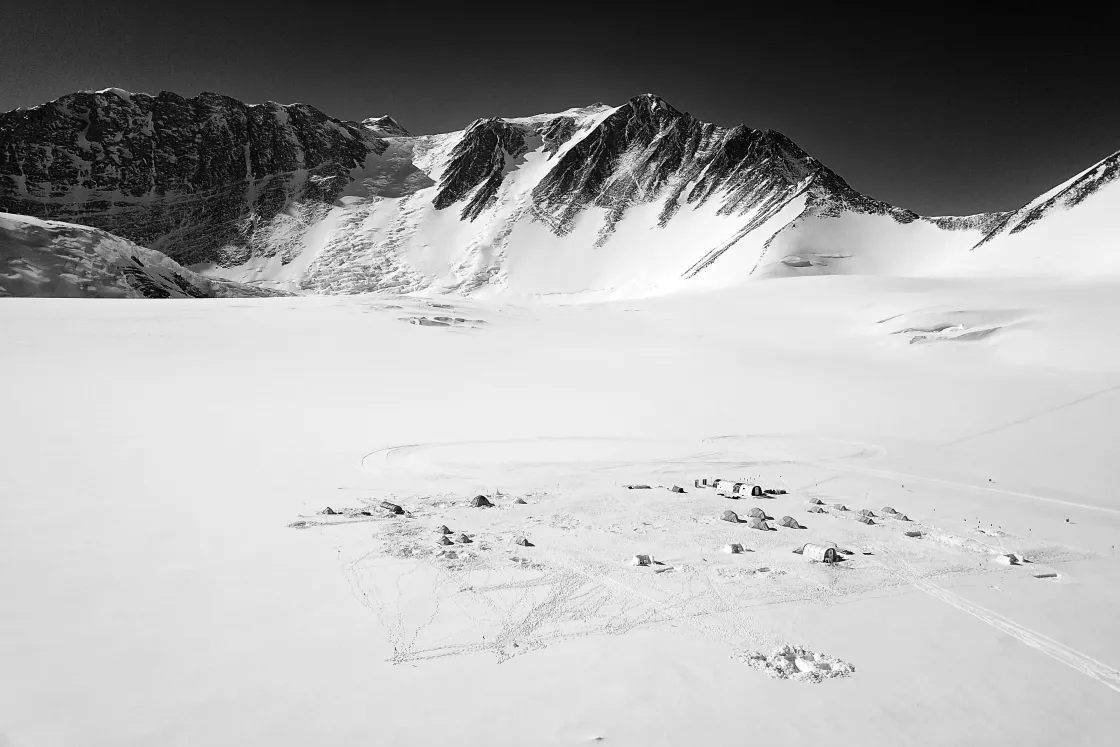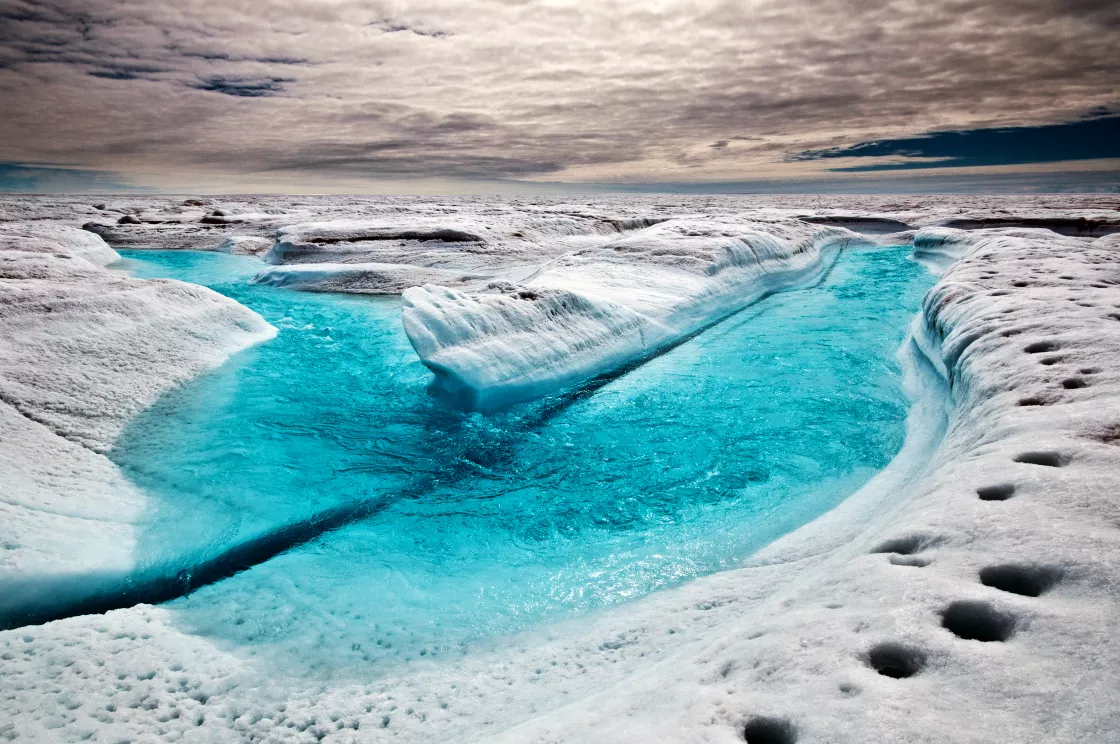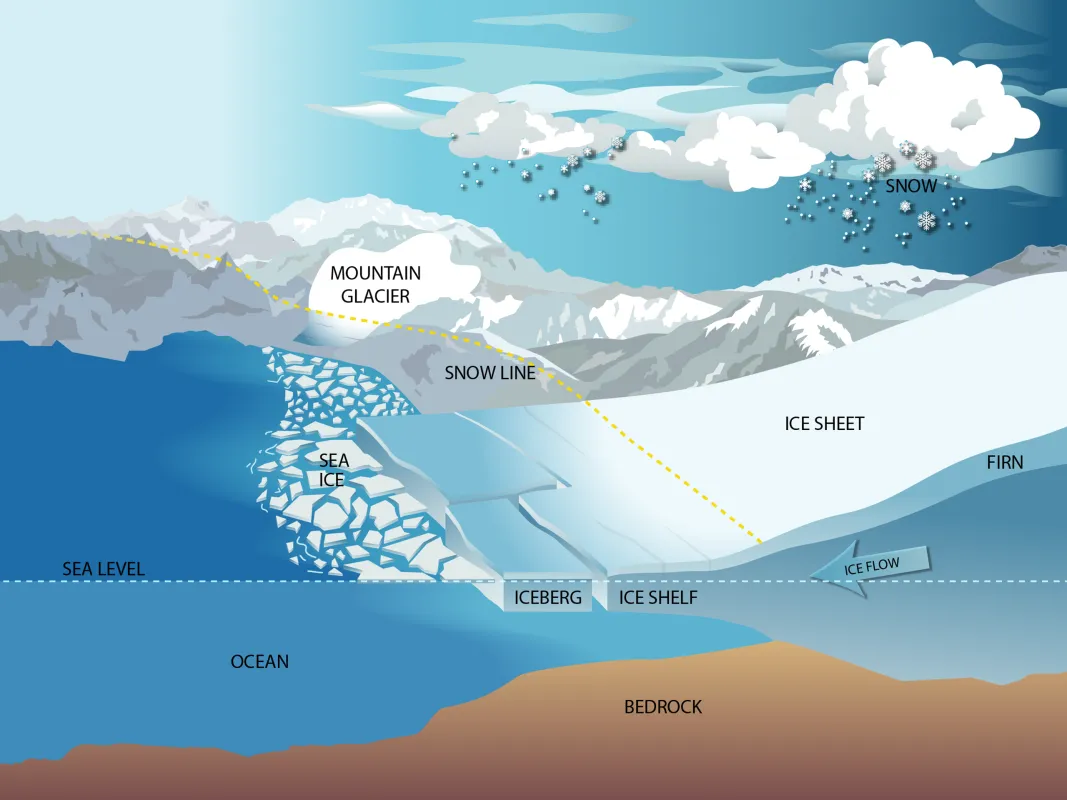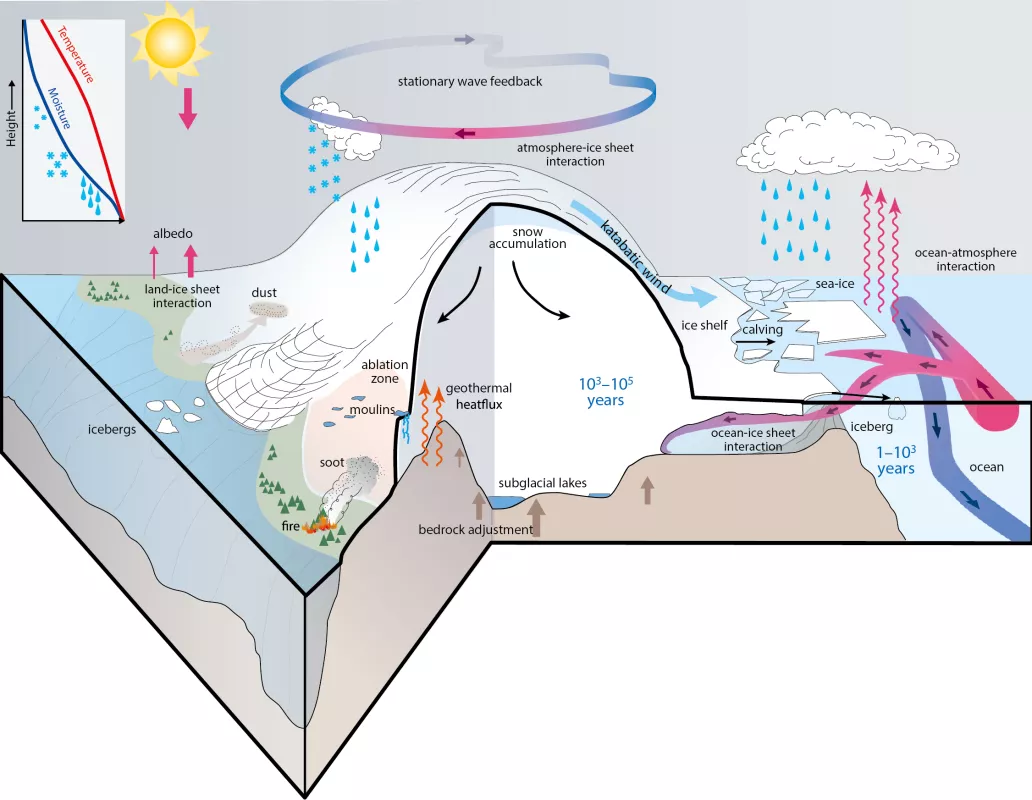Ice Sheets
Quick Facts
What is an ice sheet?
An ice sheet is a mass of glacial land ice extending more than 50,000 square kilometers (20,000 square miles). Ice sheets once covered much of the Northern Hemisphere during a series of Pleistocene Ice Ages. Now, Earth has just two ice sheets: one covers most of Greenland, the largest island in the world, and the other spans across the Antarctic continent. Ice sheets are constantly in motion, spreading out under their own weight in broad domes.
Together, the Antarctic and Greenland Ice Sheets contain more than 99 percent of the land ice and over 68 percent of the fresh water on Earth. Ice sheets are an important resource because they contribute vital ecosystem services, such as keeping fresh water frozen as ice—acting as global water towers. If global emissions continue at their current rate, Earth’s ice sheets are vulnerable to massive ice loss that could substantially raise sea levels.
For example, the Antarctic Ice Sheet covers almost 14 million square kilometers (5.4 million square miles), roughly the area of the contiguous United States and Mexico combined. The Antarctic Ice Sheet measures nearly 4.9 kilometers (3 miles) at its thickest point and contains about 30 million cubic kilometers (7.2 million cubic miles) of ice. If the entire Antarctic Ice Sheet melted, sea level would rise about 58 meters (190 feet).
The Greenland Ice Sheet covers about 80 percent of the world's largest island, stretching across 1.7 million square kilometers (656,000 square miles)—an area about three times the size of Texas. At its thickest point, the Greenland Ice Sheet measures over 3 kilometers (1.9 miles) thick and contains about 2.9 million cubic kilometers (696,000 cubic miles) of ice. If the entire Greenland Ice Sheet melted, sea level would rise about 7.4 meters (24 feet).
How much water is stored in Earth’s ice sheets?
Together, the Antarctic and Greenland Ice Sheets contain more than 99 percent of the fresh water ice on Earth. The amount of fresh water stored in both the Antarctic and Greenland Ice Sheets total over 68 percent of the fresh water on Earth.
Is an ice sheet different from a glacier?
Ice sheets are much larger than glaciers. An ice sheet is a mass of glacial land ice, extending more than 50,000 square kilometers (20,000 square miles). Ice sheets can cover underlying canyons and mountain ranges. During the last ice age, ice sheets also covered much of North America and Scandinavia. Now, Earth has two ice sheets: one covers most of Greenland, the largest island in the world, and the other spans across the Antarctic continent.
The Antarctic Ice Sheet extends almost 14 million square kilometers (5.4 million square miles), roughly the area of the contiguous United States and Mexico combined. It also contains about 30 million cubic kilometers (7.2 million cubic miles) of ice.
The Greenland Ice Sheet contains about 2.9 million cubic kilometers (0.7 million cubic miles) of ice. The ice sheet extends about 1.7 million square kilometers (656,000 square miles), covering 80 percent of the world’s largest island, and is equivalent to about three times the size of Texas. It contains about 2.9 million cubic kilometers (696,000 cubic miles) of ice.
What is an ice cap?
Ice caps are miniature ice sheets. An ice cap covers less than 50,000 square kilometers (19,300 square miles) and comprises several merged glaciers. Like ice sheets, ice caps tend to spread out in dome-like shapes as opposed to occupying a single valley or set of connected valleys.
Ice caps form in high-altitude polar and subpolar mountain regions. Northern Europe is home to many ice caps; for example, the Vatnajökull ice cap in Iceland and the Austfonna ice cap in the Svalbard archipelago of Norway, which is the largest (in area) in Scandinavia. The largest ice cap in the world is the Severny Island ice cap, part of the Novaya Zemlya archipelago in the Russian Arctic.
Ice caps are also found in mountain ranges like the Himalayas, Rockies, Andes, and the Southern Alps of New Zealand.
How do ice sheets form?
Ice sheets form in areas where snow that falls in winter does not melt entirely over the summer. Over thousands of years, the layers of snow pile up into thick masses of ice, growing thicker and denser as the weight of new snow and ice layers compresses the older layers.
Ice sheets are constantly in motion, spreading out in broad domes under their own weight. Near the coast, most of the ice moves through relatively fast-moving outlets that include ice streams, glaciers, and ice shelves. An ice sheet accumulates the same mass of snow as it loses to the sea, it remains “in balance.” Glaciologists refer to this measurement of stability as mass balance, or the net gain and loss of mass of an ice sheet. Snowfall increases the ice sheet mass. Melting, calving, or evaporation of snow or ice decreases the ice sheet mass.
In the interior of an ice sheet, surface ice flow may be only mildly reactive to topography under the ice. As an ice body gets smaller and thinner, the ice motion is more and more defined by the topography underneath/around the ice.
Why are ice sheets important?
Ice sheets contain enormous quantities of frozen water. If the Greenland Ice Sheet melted entirely, scientists estimate that sea level would rise about 7.4 meters (23 feet). If the Antarctic Ice Sheet melted, sea level would rise by about 58 meters (190 feet). While this is unlikely to occur in the near future, there is research to suggest that the entire Greenland Ice Sheet could melt by the year 3000 if the world follows a high greenhouse gas emission pathway. For most of the twentieth century, the ice sheets made very little contribution to sea level, and were nearly in balance in annual snowfall gain and ice or meltwater loss. However, the stability of the ice sheets has changed considerably in the twenty-first century.
The Greenland and Antarctic Ice Sheets also influence weather and climate. Large high-altitude plateaus on the ice sheets alter storm tracks and create cold downslope winds close to the ice surface. Known as katabatic winds, these downslope winds occur when the higher altitudes radiate heat and are cooled. As the air cools, it becomes denser. Gravity does the rest by pulling this denser air downhill.
Along with influencing the ocean and atmosphere, ice sheets are important because they contain annual layers that hold a unique and valuable record of Earth's climate history. Pockets of air bubbles locked within the ice can tell scientists what our planet’s climate was like nearly one million years ago.
Though algae lives on ice, ice sheets themselves host few animals. Flora and fauna in Greenland and Antarctica is present primarily at and beyond the ice sheet edges. One way that ice sheets help to support local ecosystems is via freshwater runoff that can be important for transporting nutrients and may play a role in establishing a food chain that supports larger mammals.



